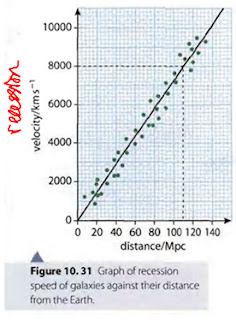The recession velocity is proportional to distance.
If the galaxy is at the distance x then Hubble's law predicts that the recessional velocity of the galaxy will be H.x. If it has been travelling at this constant speed since the beginning of the Universe, then the time that has elapsed can be calculated from the method shown in E.6.7. But this is the UPPER LIMIT OF THE AGE OF THE UNIVERSE. However, the gravitational attraction between galaxies means that the speed of recession decreases all the time. The fact that we assume that the recession velocity is constant, is therefore a limitation of Hubble's law. Also, the data points in the graph below are scattered around the trend line thus showing that there are quite big random errors in the measurements. Furthermore, there a few data points near the origin because it is difficult to measure the red shift (as it is really small) of galaxies that are close to us and moving away. This is therefore another limitation of Hubble's law.
The more data points you can get, the greater the accuracy of Hubble's law.
E.6.6 Explain how the Hubble constant may be determined.


As the images above show, the Hubble constant is the gradient of a graph that plots the recession velocity in km/s and distance in Mpc.
E.6.7 Explain how the Hubble constant may be used to determine the age of the universe.
The Big Bang started with a point of singularity - all parts of the universe were in the same place. So if we know how fast any two parts are moving apart and how far apart they are now, we can calculate the age of the universe.
To calculate the age of the universe in seconds, we first need to convert the distance into km.
This calculation assumes that the velocity is constant. However, gravitational attraction will slow galaxies down; the recessional velocity measured is therefore smaller than it was. This makes our value too large so according to these measurements, the maximum age of the the universe can't be more than 1.3 x 10^10 years.
E.6.8 Solve problems involving Hubble's law.
Resources: IB Heinemenn HL Physics by Chris Hamper (http://www.rcnuwc.org/ibphysics/) and IB Physics Study Guide by Tim Kirk.

























